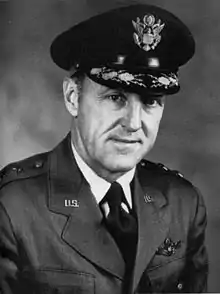Albert Boyd
Albert G Boyd (November 22, 1906 – September 18, 1976) was a pioneering test pilot for the United States Air Force (USAF). During his 30-year career, he logged more than 23,000 hours of flight time in 723 military aircraft (though this number of the total number flown includes variants and sub variants of some types, and is not 723 distinct types). When he retired in 1957, he had flown every aircraft type operated by the USAF, including attack, cargo, trainer, fighter, experimental, bomber, mission trainer, liaison, observation, and general aviation planes and helicopters.
Albert Boyd | |
|---|---|
 | |
| Nickname(s) | Al |
| Born | November 22, 1906 Rankin, Tennessee, U.S. |
| Died | September 18, 1976 (aged 69) |
| Place of burial | |
| Allegiance | |
| Service/ | |
| Years of service | 1927–1957 |
| Rank | |
| Commands held | Chief of Flight Section, Wright-Patterson AFB Commander, Experimental Test Pilot School Commander, USAF Flight Test Center at Edwards AFB Commander, Wright Air Development Center Deputy Commander, Weapons System Headquarters, ARDC |
| Awards | Legion of Merit Distinguished Flying Cross Distinguished Service Medal |
From 1947 to 1957, Boyd flew and approved every aircraft type acquired by the USAF. When he retired, he was praised as the "Father of Modern Flight Testing," "World's Number One Test Pilot," "Dean of American Test Pilots" and "Father of USAF Test Pilots."
His assignments included:
- Chief of Flight Section at Wright Patterson AFB
- Commander, Experimental Test Pilot School
- First Commander, USAF Flight Test Center at Edwards Air Force Base
- Commander, Wright Air Development Center (Maj. Chuck Yeager, a test pilot in his command, was the first American pilot to test the MiG-15, associated with Operation Moolah.)
- Deputy Commander, Weapons System Headquarters, Air Research and Development Command
Commanding General of Edwards AFB
The prototype Lockheed P-80 Shooting Star, modified as a racer and designated P-80R,[1] was piloted by Colonel Boyd to 623.73 mph (1,004.2 km/h) on 19 June 1947. This was recognised as an official air speed record, although this speed had already been exceeded by the Me 163 and Me 262 in 1944.[2]
Boyd led the newly-formed Air Force's X-1 supersonic flight program and made the selection of Chuck Yeager to pilot the plane.[3]:98 Yeager described Boyd as a strict disciplinarian who would enforce (often with a very loud voice) USAF uniform regulations. He remarked that "You might be his star pilot, but Lord help you if you came before him in his office with an un-shined belt buckle". Boyd was highly respected by his subordinates.
Boyd died on September 18, 1976. He and his wife Anna Lu (1907–1981) are buried at Arlington National Cemetery.[4]
Awards
- Octave Chanute Award
- Legion of Merit
- Distinguished Flying Cross
- Distinguished Service Medal
- Air Power Trophy
- Schilling Award
- Médaille de l'Aéronautique
- Brevet Militarire de Pilote d'Aviation
- Aerospace Walk of Honor (1991)[5]
References
- "P-80 Shooting Star/44-85200." Archived 2015-01-12 at the Wayback Machine National Museum of the USAF. Retrieved: 9 October 2012.
- Francillon 1982, pp. 241-242
- Yeager, Chuck; Janos, Leo (1985). Yeager, An Autobiography.
- Burial Detail: Boyd, Albert (Section 11, Grave 773-1) – ANC Explorer
- Chandler, John (September 17, 1991). "Neil Armstrong to Join Lancaster Walk of Honor". The Los Angeles Times. Los Angeles, California. p. B3 – via Newspapers.com.
- City of Lancaster AWOH biography retrieved February 5, 2011.
- Air Force Link Biography retrieved February 5, 2011.
External links
- Albert Boyd at ArlingtonCemetery•net, an unofficial website
